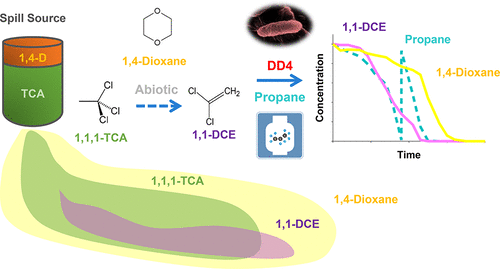当前位置:
X-MOL 学术
›
Environ. Sci. Technol. Lett.
›
论文详情
Our official English website, www.x-mol.net, welcomes your
feedback! (Note: you will need to create a separate account there.)
Synchronic Biotransformation of 1,4-Dioxane and 1,1-Dichloroethylene by a Gram-Negative Propanotroph Azoarcus sp. DD4
Environmental Science & Technology Letters ( IF 8.9 ) Pub Date : 2018-07-18 , DOI: 10.1021/acs.estlett.8b00312 Daiyong Deng 1 , Fei Li 1 , Chen Wu 1 , Mengyan Li 1
Environmental Science & Technology Letters ( IF 8.9 ) Pub Date : 2018-07-18 , DOI: 10.1021/acs.estlett.8b00312 Daiyong Deng 1 , Fei Li 1 , Chen Wu 1 , Mengyan Li 1
Affiliation

|
Bioremediation of 1,4-dioxane is strongly challenged by the concurrent contamination of chlorinated solvents, particularly 1,1-dichloroethylene (1,1-DCE), a potent inhibitor of archetypic 1,4-dioxane degraders (e.g., Pseudonocardia and Mycobacterium). Vegetative growth and aggregation behavior of these Gram-positive Actinomycetes also hinder their field application. A new Gram-negative bacterium Azoarcus sp. DD4 was isolated from an activated sludge sample. Notably, DD4 can sustain the concurrent co-oxidation of 1,4-dioxane and 1,1-DCE using propane as the primary substrate without observable formation of clumps. Microcosm assays prepared with source zone groundwater samples from a contaminated site indicated DD4 can efficiently remove dioxane, with the concentration decreasing from an initial value of 10.4 mg/L to <0.4 μg/L within 14 days of incubation. Removal of 1,4-dioxane was partially inhibited when an excessive amount of 1,1-DCE (3.28 ± 0.19 mg/L) was artificially spiked into the microcosms but significantly accelerated immediately after the complete depletion of 1,1-DCE. Furthermore, a gene encoding a putative propane monooxygenase was discovered, which may contribute to the oxidation of propane, 1,4-dioxane, and/or 1,1-DCE. Detection of 2-S-glutathionyl acetate and synchronic dechlorination suggest that DD4 detoxifies its primary metabolite, 1,1-DCE epoxide, via conjugation with glutathione. All these findings indicate the suitability of DD4 as a robust inoculum candidate for in situ bioaugmentation to remediate co-contamination by dioxane and 1,1-DCE.
中文翻译:

革兰氏阴性丙烷营养菌Azoarcus sp。对1,4-二恶烷和1,1-二氯乙烯的同步生物转化。DD4
1,4-二恶烷的生物修复受到氯化溶剂尤其是1,1-二氯乙烯(1,1-DCE)的同时污染的挑战,这是一种典型的1,4-二恶烷降解剂(如假性心包炎和分枝杆菌)的有效抑制剂。这些革兰氏阳性放线菌的营养生长和聚集行为也阻碍了它们的田间应用。新型革兰氏阴性菌偶氮固氮菌sp。从活性污泥样品中分离出DD4。值得注意的是,DD4可以将丙烷用作主要底物,同时维持1,4-二恶烷和1,1-DCE的共氧化,而不会形成团块。用来自受污染地点的源区地下水样品进行的微观分析表明,DD4可以有效去除二恶烷,在孵育14天之内,其浓度从初始值10.4 mg / L降至<0.4μg/ L。当人为地将过量的1,1-DCE(3.28±0.19 mg / L)掺入到微观世界中时,部分抑制了1,4-二恶烷的去除,但在1,1-DCE完全耗尽后立即明显加速了去除。此外,发现了编码推定的丙烷单加氧酶的基因,该基因可能有助于丙烷,1,4-二恶烷和/或1,1-DCE的氧化。S-谷胱甘肽乙酸盐和同步脱氯表明DD4通过与谷胱甘肽结合来解毒其主要代谢产物1,1-DCE环氧化物。所有这些发现表明,DD4作为原位生物增强的可靠接种物的适宜性,以补救由二恶烷和1,1-DCE造成的共污染。
更新日期:2018-07-19
中文翻译:

革兰氏阴性丙烷营养菌Azoarcus sp。对1,4-二恶烷和1,1-二氯乙烯的同步生物转化。DD4
1,4-二恶烷的生物修复受到氯化溶剂尤其是1,1-二氯乙烯(1,1-DCE)的同时污染的挑战,这是一种典型的1,4-二恶烷降解剂(如假性心包炎和分枝杆菌)的有效抑制剂。这些革兰氏阳性放线菌的营养生长和聚集行为也阻碍了它们的田间应用。新型革兰氏阴性菌偶氮固氮菌sp。从活性污泥样品中分离出DD4。值得注意的是,DD4可以将丙烷用作主要底物,同时维持1,4-二恶烷和1,1-DCE的共氧化,而不会形成团块。用来自受污染地点的源区地下水样品进行的微观分析表明,DD4可以有效去除二恶烷,在孵育14天之内,其浓度从初始值10.4 mg / L降至<0.4μg/ L。当人为地将过量的1,1-DCE(3.28±0.19 mg / L)掺入到微观世界中时,部分抑制了1,4-二恶烷的去除,但在1,1-DCE完全耗尽后立即明显加速了去除。此外,发现了编码推定的丙烷单加氧酶的基因,该基因可能有助于丙烷,1,4-二恶烷和/或1,1-DCE的氧化。S-谷胱甘肽乙酸盐和同步脱氯表明DD4通过与谷胱甘肽结合来解毒其主要代谢产物1,1-DCE环氧化物。所有这些发现表明,DD4作为原位生物增强的可靠接种物的适宜性,以补救由二恶烷和1,1-DCE造成的共污染。











































 京公网安备 11010802027423号
京公网安备 11010802027423号